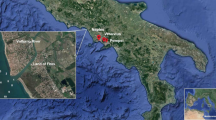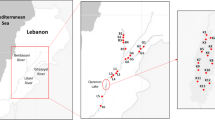Abstract
Polychlorinated biphenyls (PCBs) were monitored in surface water collected in the Selangor River basin, Malaysia, to identify the occurrence, distribution, and dechlorination process as well as to assess the potential adverse effects to the Malaysian population. Ten PCB homologs (i.e., mono-CBs to deca-CBs) were quantitated by using gas chromatography-mass spectrometry (GC/MS). The total concentration of PCBs in the 10 sampling sites ranged from limit of detection to 7.67 ng L−1. The higher chlorinated biphenyls (tetra-CBs to deca-CBs) were almost not detected in most of the sampling sites, whereas lower chlorinated biphenyls (mono-CBs, di-CBs, and tri-CBs) dominated more than 90 % of the 10 homologs in all the sampling sites. Therefore, the PCB load was estimated to be negligible during the sampling period because PCBs have an extremely long half-life. The PCBs, particularly higher chlorinated biphenyls, could be thoroughly dechlorinated to mono-CBs to tri-CBs by microbial decomposition in sediment or could still be accumulated in the sediment. The lower chlorinated biphenyls, however, could be resuspended or desorbed from the sediment because they have faster desorption rates and higher solubility, compared to the higher chlorinated biphenyls. The health risk for the Malaysia population by PCB intake that was estimated from the local fish consumption (7.2 ng kg−1 bw day−1) and tap water consumption (1.5 × 10−3–3.1 × 10−3 ng kg−1 bw day−1) based on the detected PCB levels in the surface water was considered to be minimal. The hazard quotient based on the tolerable daily intake (20 ng kg−1 bw day−1) was estimated at 0.36.


Similar content being viewed by others
References
Aichner, B., Glazer, B., & Zech, W. (2007). Polycyclic aromatic hydrocarbons and polychlorinated biphenyls in urban soils in Kathmandu, Nepal. Organic Geochemistry, 38(4), 700–715.
Ashraf M.A., Maah M.J., Yusoff I. (2012). Morphology, geology and water quality assessment of former tin mining catchment. Scientific World Journal 2012, 369206.
Azmi Jr., M. Y., Junidah, R., Siti, M. A., Safiah, M. Y., Fatimah, S., Norimah, A. K., Poh, B. K., Kandiah, M., Zalilah, M. S., Wan Abdul Manan, W., Siti Haslinda, M. D., & Tahir, A. (2009). Body mass index (BMI) of adults: findings of the Malaysian adult nutrition survey (MANS). Malaysian Journal of Nutrition, 15(2), 97–119.
Beurskens, J. E. M., Mol, G. A. J., Barreveld, H. L., Van Munster, B., & Winkels, H. J. (1993). Geochronology of priority pollutants in a sedimentation area of the Rhine River. Environmental Toxicology and Chemistry, 12, 1549–1566.
Boul, H. L. (1995). DDT residues in the environment—a review with a New Zealand perspective. New Zealand Journal of Agricultural Research, 38(2), 257–277.
Breivik, K., Sweetman, A., Pacyna, J. M., & Jones, K. C. (2002). Towards a global historical emission inventory for selected PCB congeners—a mass balance approach. 1. Global production and consumption. Science of the Total Environment, 290, 181–198.
Brown Jr., J. F., Wagner, R. E., Bedard, D. L., Brennan, M. J., Carnahan, J. C., & May, R. J. (1984). PCB transformation in upper Hudson sediments. Northeastern Environmental Science, 3, 167–179.
Brown Jr., J. F., Bedard, D. L., Brennan, M. J., Carnahan, J. C., Feng, H., & Wagner, R. E. (1987). Polychlorinated biphenyl dechlorination in aquatic sediments. Science, 236(4802), 709–712.
Chang, F. C., Chiu, T. C., Yen, J. H., & Wang, Y. S. (2003). Dechlorination pathways of ortho-substituted PCBs by UV irradiation in n-hexane and their correlation to the charge distribution on carbon atom. Chemosphere, 51(8), 775–784.
Department of Environment, Ministry of Natural Resources and Environment (2008). Malaysia Environment Quality Report 2008. Available at http://www.doe.gov.my/webportal/en/penerbitan-jas/. [Accessed 6 April, 2014]
Department of Environment, Ministry of Natural Resources and Environment (2009). Malaysia Environment Quality Report 2009. Available at http://www.doe.gov.my/webportal/en/penerbitan-jas/. [Accessed 6 April, 2014]
Food and Agriculture Organization of the United Nation (2009). Food and Agriculture Organization Corporate Statistical Database (FAOSTAT). Available at http://faostat3.fao.org/download/FB/CL/E. [Accessed 7 November, 2014]
Frame, G. M., Cochran, J. W., & Boewadt, S. S. (1996). Complete PCB congener distributions for 17 Aroclor mixtures determined by 3 HRGC systems optimized for comprehensive, quantitative, congener-specific analysis. Journal of High Resolution Chromatography, 19(12), 657–668.
Ghosh, U., Weber, A. S., Jensen, J. N., & Smith, J. R. (2000). Relationship between PCB desorption equilibrium, kinetics, and availability during land biotreatment. Environmental Science & Technology, 34(12), 2542–2548.
Ivanciuc, T., Ivanciuc, O., & Klein, D. J. (2006). Modeling the bioconcentration factors and bioaccumulation factors of polychlorinated biphenyls with posetic quantitative super-structure/activity relationships (QSSAR. Molecular Diversity, 10(2), 133–145.
Iwata, H., Tanabe, S., Sakai, N., Nishimura, A., & Tatsukawa, R. (1994). Geographical distribution of persistent organochlorines in air, water and sediments from Asia and Oceania, and their implications for global redistribution from lower latitudes. Environmental Pollution, 85(1), 15–33.
Jensen, S. (1966). Report of a new chemical hazard. New Scientist, 32, 612.
Kannan, K., Tanabe, S., Giesy, J. P., & Tatsukawa, R. (1997). Organochlorine pesticides and Polychlorineted biphenyls in foodstuffs from Asian and oceanic countries. Reviews of Environmental Contamination and Toxicology, 152, 1–55.
Kim, H. K., Masaki, H., Matsumura, T., Kamei, T., & Magara, Y. (2002). Removal efficiency and homologue patterns of dioxins in drinking water treatment. Water Research, 36(19), 4861–4869.
Lépine, F., Milot, S., & Vincent, N. (1992). Formation of toxic PCB congeners and PCB-solvent adducts in a sunlight irradiated cyclohexane solution of Aroclor 1254. Bulletin of Environmental Contamination and Toxicology, 48, 152–156.
Magar, V. S., Johnson, G. W., Brenner, R. C., Quensen 3rd, J. F., Foote, E. A., Durell, G., Ickes, J. A., & Peven-McCarthy, C. (2005). Long-term recovery of PCB-contaminated sediments at the Lake Hartwell superfund site: PCB dechlorination. 1. End-member characterization. Environmental Science & Technology, 39(10), 3538–3547.
Manodori, L., Gambaro, A., Piazza, R., Ferrari, S., Stortini, A. M., Moret, I., & Capodaglio, G. (2006). PCBs and PAHs in sea-surface microlayer and sub-surface water samples of the Venice lagoon (Italy. Marine Pollution Bulletin, 52(2), 184–192.
Maskaoui, K., Zhou, J. L., Zheng, T. L., Hong, H., & Yu, Z. (2005). Organochlorine micropollutants in the Jiulong River estuary and western Xiamen Sea, China. Marine Pollution Bulletin, 51(8), 950–959.
Mohamad, A., Azlan, A., Razman, M. R., Ramli, N. A., & Latiff, A. A. (2013). Polychlorinated biphenyls (PCBs) concentration in demersal fish and shellfish from west coast of peninsular Malaysia. Journal of Food Agriculture and Environment, 11(1), 1094–1098.
Monirith, I., Ueno, D., Takahashi, S., Nakata, H., Sudaryanto, A., Subramanian, A., Karuppiah, S., Ismail, A., Muchtar, M., Zheng, J., Richardson, B. J., Prudente, M., Hue, N. D., Tana, T. S., Tkalin, A. V., & Tanabe, S. (2003). Asia-Pacific mussel watch: monitoring contamination of persistent organochlorine compounds in coastal waters of Asian countries. Marine Pollution Bulletin, 46(3), 281–300.
Nilsson, T., Bøwadt, S., & Björklund, E. (2002). Development of a simple selective SFE method for the determination of desorption behaviour of PCBs in two Swedish sediments. Chemosphere, 46(3), 469–476.
Othman, F., Alaa-Eldin, M. E., & Mohamed, I. (2012). Trend analysis of a tropical urban river water quality in Malaysia. Journal of Environmental Monitoring, 14(12), 3164–3173.
Petrovic, M., Eljarrat, E., Lopez De Alda, M. J., & Barcelo, D. (2001). Analysis and environmental levels of endocrine disrupting compounds in freshwater sediments. Trends in Analytical Chemistry, 20(11), 637–648.
Rodenburg, L. A., Du, S., Fennell, D. E., & Cavallo, G. J. (2010). Evidence for widespread dechlorination of polychlorinated biphenyls in groundwater, landfills, and wastewater collection systems. Environmental Science & Technology, 44(19), 7534–7540.
Rodziewicz, M., Kaczmarczyk, A., & Niemirycz, E. (2004). Polychlorinated biphenyls in the sediments of the Odra River and its tributaries. Polish Journal of Environmental Studies, 13(2), 203–208.
Saadati, N., Abdullah, M. P., Zakaria, Z., Sany, S. B., Rezayi, M., & Hassonizadeh, H. (2013). Limit of detection and limit of quantification development procedures for organochlorine pesticides analysis in water and sediment matrices. Chemistry central. Journal, 7(1), 63.
Sahu, S. K., Ajmal, P. Y., Pandit, G. G., & Puranik, V. D. (2009). Vertical distribution of polychlorinated biphenyl congeners in sediment core from Thane Creek area of Mumbai, India. Journal of Hazardous Materials, 164(2–3), 1573–1579.
Santhi, V. A., Sakai, N., Ahmad, E. D., & Mustafa, A. M. (2012). Occurrence of bisphenol a in surface water, drinking water and plasma from Malaysia with exposure assessment from consumption of drinking water. Science of the Total Environment, 427, 332–338.
Sheikh, M. A., Nakama, F., & Oomori, T. (2007). Distribution characteristics of polychlorinated biphenyls (PCBs) in coastal areas of Okinawa Island, Japan. Chinese Journal of Oceanology and Limnology, 25(3), 247–253.
Sinkkonen, S., & Paasivirta, J. (2000). Degradation half-life times of PCDDs, PCDFs and PCBs for environmental fate modeling. Chemosphere, 40, 943–949.
Sudaryanto, A., Kunisue, T., Tanabe, S., Niida, M., & Hashim, H. (2005). Persistent organochlorine compounds in human breast milk from mothers living in Penang and Kedah, Malaysia. Archives of Environmental Contamination and Toxicology, 49(3), 429–437.
van de Merwe, J. P., Hodge, M., Olszowy, H. A., Whittier, J. M., Ibrahim, K., & Lee, S. Y. (2009). Chemical contamination of green turtle (Chelonia mydas) eggs in peninsular Malaysia: implications for conservation and public health. Environmental Health Perspectives, 117(9), 1397–1401.
van de Merwe, J. P., Hodge, M., Whittier, J. M., Ibrahim, K., & Lee, S. Y. (2010). Persistent organic pollutants in the green sea turtle Chelonia mydas: nesting population variation, maternal transfer, and effects on development. Marine Ecology Progress Series, 403, 269–278.
Watanabe M., Niida M., Hashim H., Tanabe S. (2003). Contamination by polychlorinated biphenyls (PCBs), dibenzo-p-dioxins (PCDDs) and dibenzofurans (PCDFs) in soils from dumping sites of municipal wastes in Malaysia. Presented in the PCB Symposium 2003 in Malaysia, February 24–15, 2003. Available at http://tabemono.info/report/former/pcd/english.html [Accessed 9 September, 2016]
World Health Organization (2003). Concise International Chemical Assessment Document 55. Polychlorinated biphenyls: human health aspects. The International Programme on Chemical Safety (IPCS): Geneva, Switzerland. Available at http://www.who.int/ipcs/publications/cicad/en/cicad55.pdf. [Accessed 6 April 2014]
Wöstena, J. H. M., Ismailb, A. B., & van Wijk, A. L. M. (1997). Peat subsidence and its practical implications: a case study in Malaysia. Geoderma, 78(1), 25–36.
Yan, S., Rodenburg, L. A., Dachs, J., & Eisenreich, S. J. (2008). Seasonal air-water exchange fluxes of polychlorinated biphenyls in the Hudson River estuary. Environmental Pollution, 152(2), 443–451.
Yao, Y., Takasuga, T., Masunaga, S., & Nakanishi, J. (2002). Detailed study on the levels of polychlorinated dibenzo-p-dioxins, polychlorinated dibenzofurans and polychlorinated biphenyls in Yusho rice oil. Chemosphere, 46(9–10), 1461–1469.
Zahed, M. A., Nabi Bidhendi, G., Pardakhti, A., Esmaili-Sari, A., & Mohajeri, S. (2009). Determination of polychlorinated biphenyl congeners in water and sediment in north west Persian gulf, Iran. Bulletin of Environmental Contamination and Toxicology, 83(6), 899–902.
Acknowledgments
This study was funded by UM/MOE HIR Grant (E000005-20001) and United Nations University (Tokyo) program on environmental governance in East Asia. Additionally, this work was supported under the framework of “Research and Education Center for Risk Based Asian Oriented Integrated Watershed Management,” funded by the JSPS Asian CORE Program and Ministry of Education, Malaysia.
Author information
Authors and Affiliations
Corresponding author
Rights and permissions
About this article
Cite this article
Sakai, N., Dayana, E., Abu Bakar, A. et al. Occurrence, distribution, and dechlorination of polychlorinated biphenyls and health risk assessment in Selangor River basin. Environ Monit Assess 188, 592 (2016). https://doi.org/10.1007/s10661-016-5595-6
Received:
Accepted:
Published:
DOI: https://doi.org/10.1007/s10661-016-5595-6




